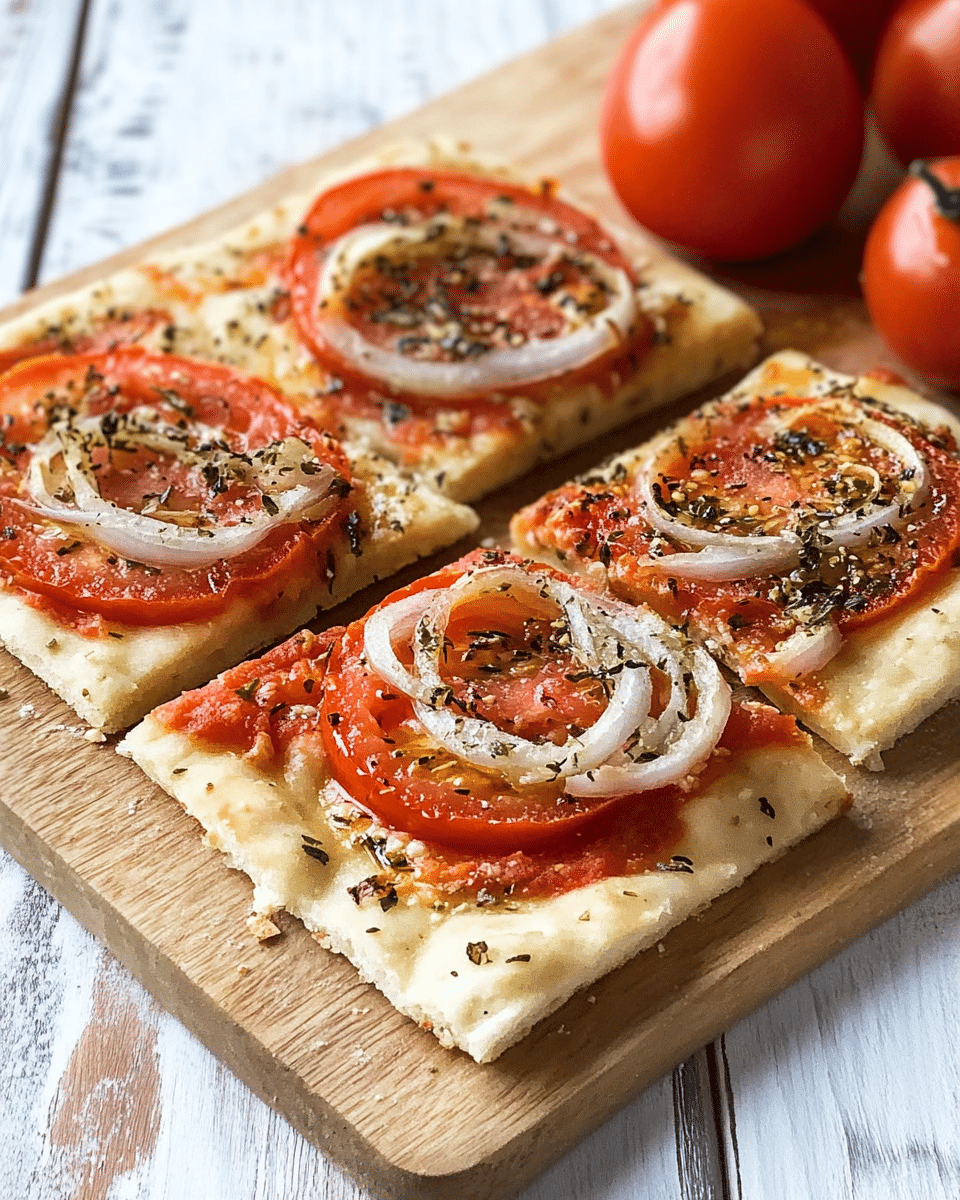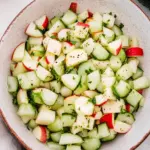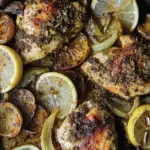This traditional Greek dish, Ladenia, hails from the tiny island of Kimolos in the Cyclades and is often described as the Aegean’s answer to pizza. But unlike its cheesy cousin, Ladenia is a minimalist celebration of just a few high-quality ingredients: ripe tomatoes, sweet onions, fragrant oregano, and lots of golden Greek olive oil. What makes Ladenia so special is its simplicity. The dough is soft and slightly chewy, forming a rustic flatbread base that soaks up the flavorful olive oil while crisping around the edges. The toppings are fresh and plant-based, making this an ideal dish for vegans, those observing Greek Orthodox fasting traditions, or anyone craving a lighter take on traditional baked goods. Perfect as an appetizer, light lunch, or paired with wine for a casual evening on the patio, Ladenia brings a little island magic into your kitchen.
Full Recipe:
Ingredients:
-
2 cups all-purpose flour
-
1/2 cup warm water
-
1/3 cup olive oil (plus extra for drizzling)
-
1 tsp dry yeast
-
1 tsp salt
-
1 large onion, thinly sliced
-
2 medium tomatoes, sliced
-
1/2 tsp dried oregano
-
Freshly ground black pepper
Directions:
-
In a bowl, dissolve yeast in warm water and let sit for 5–10 minutes until foamy.
-
Mix in flour, salt, and olive oil. Knead until smooth and elastic. Cover and let rise for 1 hour.
-
Preheat oven to 400°F (200°C).
-
Roll out dough on an oiled baking sheet to form a rustic, thick flatbread base.
-
Top with tomato slices and onion rings evenly across the surface.
-
Drizzle generously with olive oil, sprinkle oregano and black pepper.
-
Bake for 35–40 minutes until edges are golden and crisp.
-
Cool slightly before slicing and serving.
Prep Time: 10 minutes | Cooking Time: 40 minutes | Total Time: 50 minutes
Kcal: 310 kcal | Servings: 4 servings
Ladenia – The Ancient Greek Flatbread You’ll Fall in Love With
If you’re seeking a recipe that captures the spirit of Greek simplicity, cultural heritage, and wholesome flavors, look no further than Ladenia. Known as one of the oldest recorded pizza-like dishes in the Mediterranean, Ladenia is a traditional flatbread from the picturesque island of Kimolos in the Cyclades. With its basic yet flavorful ingredients typically just flour, olive oil, tomatoes, onions, and herbs it’s a testament to how less is more when quality ingredients and traditional cooking methods are used.
Ladenia is more than just a flatbread; it is a culinary time capsule, passed down through generations and rooted deeply in the Aegean way of life. This humble dish, devoid of cheese or meat, is a stunning example of how Greek cuisine excels at crafting delicious, satisfying meals from just a few pantry staples.
A Brief History of Ladenia
Ladenia (λαδένια) gets its name from the Greek word “ladi,” meaning oil specifically olive oil, which plays a central role in the Mediterranean diet and in Greek cooking traditions. The dish dates back centuries and is especially tied to the island of Kimolos, where olive oil was plentiful but other ingredients were not always readily available. The locals used what they had freshly milled flour, homegrown tomatoes, local onions, and their own olive oil to create this savory pie.
In times of religious fasting when animal products were avoided, Ladenia became a staple dish. Even today, it’s commonly enjoyed during periods such as Lent, when dairy, eggs, and meat are restricted. This vegan-friendly bread evolved not out of modern trends, but from centuries-old customs of frugality, seasonality, and respect for ingredients.
Cultural Significance in Greek Cuisine
Greek food is intrinsically tied to community and tradition. Dishes like Ladenia are often found at family gatherings, village festivals, and local bakeries. In many homes on Kimolos and surrounding islands, Ladenia is still prepared the old-fashioned way by hand-kneading the dough and baking it in wood-fired ovens. It’s also commonly made in large trays and shared communally.
What sets Ladenia apart culturally is that it reflects the island’s history and the importance of olive oil in Greek life. Olive oil has long symbolized peace, fertility, and health, and is central to both religious rituals and everyday cooking. Ladenia, rich with olive oil, embodies all of these meanings, especially when served as a simple offering to guests or at celebrations where meatless dishes are desired.
Health Benefits and Nutritional Value
Despite its simplicity, Ladenia is surprisingly nutritious. Its base is made from flour and olive oil, providing a rich source of healthy fats and carbohydrates. Olive oil, especially the extra virgin kind typically used in Greek kitchens, is packed with antioxidants and anti-inflammatory properties. The generous use of olive oil in Ladenia helps support heart health, reduces inflammation, and adds richness without the need for butter or animal fats.
The inclusion of fresh tomatoes and onions further enhances the health profile of this dish. Tomatoes are high in lycopene, an antioxidant linked to many health benefits including reduced risk of heart disease and cancer. Onions offer antibacterial properties, fiber, and essential nutrients such as vitamin C and B6.
Because it contains no animal products, Ladenia is naturally cholesterol-free and suitable for a variety of dietary needs, including vegan and dairy-free diets. It can also be customized with whole wheat flour for added fiber or gluten-free flour for those with celiac disease.
How Ladenia Differs from Pizza
At first glance, Ladenia might remind you of pizza and that’s a fair comparison. However, the two are distinct both in preparation and purpose. Pizza, especially in its modern, commercial forms, tends to be heavier, with rich cheeses, meats, and complex sauces. Ladenia, on the other hand, is intentionally minimalist.
There’s no cheese in the traditional Ladenia, no tomato sauce, and certainly no meat. The tomatoes and onions are used fresh and layered directly on the dough. The result is more of a rustic flatbread or savory pie than the pizza most people are familiar with. And while pizza is often served hot and immediately, Ladenia is equally delicious at room temperature, making it ideal for picnics, snacks, or packed lunches.
When and How to Serve Ladenia
Ladenia is an incredibly versatile dish. It can be served as a light lunch, a side dish, an appetizer, or even as part of a meze platter. In Greece, it’s often eaten as a mid-morning or afternoon snack, sometimes accompanied by a glass of ouzo or homemade wine. Because it holds up well at room temperature, it’s also a popular choice for traveling or beach outings.
It pairs beautifully with Greek salads, olives, pickled vegetables, or fresh cheeses (for those not observing a fast). The subtle sweetness of the onions combined with the tangy tomatoes and earthy olive oil makes for a flavor that’s both comforting and sophisticated.
In modern kitchens, home cooks have taken to adding their own touches maybe a sprinkle of capers, some kalamata olives, or thin slices of zucchini but purists will tell you that the classic tomato and onion combination is where the magic truly lies.
Tips for Making the Perfect Ladenia
While Ladenia is a simple recipe, a few key tips can elevate your final dish:
-
Use high-quality olive oil: Since olive oil is central to the flavor, invest in the best extra virgin olive oil you can find.
-
Let the dough rise fully: A well-proofed dough ensures a soft yet crisp base. Don’t rush the process.
-
Slice your vegetables thinly: This ensures even cooking and prevents soggy spots.
-
Generously oil the baking tray: Not only does this prevent sticking, but it also contributes to the signature crispy, golden bottom.
-
Don’t skimp on oregano: This humble herb brings the entire flavor profile together and is essential for authenticity.
Why Ladenia Deserves a Spot in Your Recipe Collection
Ladenia is a recipe worth keeping in your repertoire, not just for its taste but for what it represents sustainability, history, and the art of simplicity. It’s a go-to dish when you want something homemade but unfussy, filling but light, and familiar yet distinctly Mediterranean.
In an age where fast food and fusion dominate, Ladenia takes us back to the basics. It reminds us that some of the most memorable meals are the ones with the fewest ingredients. All it asks is for you to use what’s in season, cook with care, and share with others.
Conclusion:
Ladenia is far more than a tomato-onion flatbread. It’s a culinary link to a slower, more intentional way of living. It captures the spirit of the Greek islands, where food is more than nourishment it’s a ritual, a celebration, and a bond between people and place. Whether you’re new to Greek cooking or a long-time fan of Mediterranean cuisine, this recipe offers an accessible, delicious way to connect with one of Greece’s hidden food treasures.






